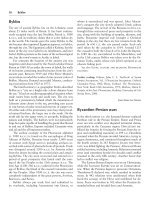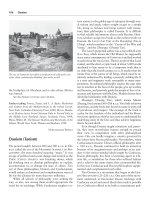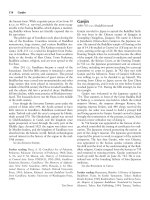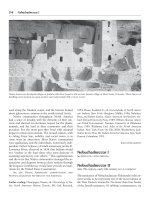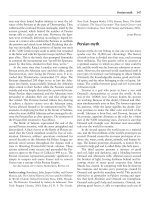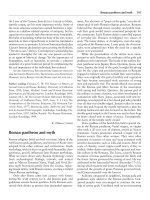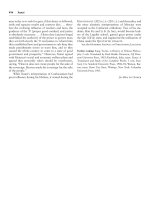Encyclopedia of world history (facts on file library of world history) 7 volume set ( PDFDrive ) 241
Bạn đang xem bản rút gọn của tài liệu. Xem và tải ngay bản đầy đủ của tài liệu tại đây (96.24 KB, 1 trang )
202
Homeric epics
greatest foreign expansion. They were able to expand the
kingdom throughout all of Syria, defeating Mittani, and
extending almost as far south as Damascus. Battles with
the Egyptians, most famously the Battle at Kadesh, led to
a treaty between Hattushili III and Ramses II in which a
Hittite princess was given to Ramses in marriage.
Although the treaty with Egypt remained in force for
the remainder of the Hittite New Kingdom, new threats
arose that eventually led to the demise of the Hittites. Assyria under Shalmaneser I became aggressive toward the
Hittites. In addition, various smaller nations surrounding the Hittite homeland began to pressure the Hittites
militarily and economically.
Unfortunately, it is still impossible to tell the exact
nature of the downfall of the Hittite capital Hattusha.
What is clear is that limited Hittite rule continued in
other areas, particularly Carchemish. These local centers
were ruled by Neo-Hittite dynasties governing individual city-states. These city-states were eventually absorbed
into the Neo-Assyrian Empire.
Hittite religion and cultic practices are becoming increasingly better known through archaeological excavations. Unfortunately, no mythological text in the old Hittite script has yet been discovered. However, one myth of
west Semitic origin has been found in a Hittite translation. It tells the story of the virtuous young male BaalHaddu refusing the advances of the married Asherah in
a fashion reminiscent of the biblical account of Joseph
and Potipher’s wife found in the book of Genesis. Cultic
practices are illuminated in the various festival descriptions found in royal archives and in texts from provincial centers. Much is known about these festivals, special
times when the statue of the deity was brought out from
the temple and honored with sacrifices and offerings given amid music and dancing. New moon festivals were
held to mark the beginning of each new month.
Knowledge of ancient Near Eastern temples, including the Solomonic Temple of the Old Testament,
is greatly advanced through the excavations of various
Hittite temples. At least five temples have been uncovered in the capital of Hattusha, and some estimate there
to be as many as 20 present in the city. Every Hittite city
had at least one temple staffed by both male and female
personnel serving as cooks, musicians, artisans, farmers, and herders.
See also Babylon: early period; Babylon, later
periods; Egypt, culture and religion; Fertile
Crescent.
Further reading: Bryce, T. The Kingdom of the Hittites.
Oxford: Oxford University Press, 1998; Hoffner, H. A., Jr.
“Hittites.” In A. J. Hoerth, G. L. Mattingly, and E. M. Yamauchi. Peoples of the Old Testament World. Grand Rapids,
MI: Baker Books, 1994.
Eric Smith
Homeric epics
The epics of the Greek writer Homer—the Iliad and
the Odyssey—are the earliest and the best known of
classics of Greek literature. Both are long epic poems,
and several scholars have argued that different people
probably wrote the two, with some academics arguing
against even the existence of Homer. Certainly, all that
is known about Homer is from tradition and evidence
gleaned from the epics.
The cities of Argos, Athens, Chios, Colophon,
Rhodes, Salamis, and Izmir (Smyrna) all claim that
Homer was born in their city. Homer was probably a
Greek from Asia Minor (modern-day Turkey), as his
writings used the Ionic and the Aeolic dialects of that
region, so the claims of Chios and Izmir are the most
plausible.
Many centuries later there was a clan at Chios
known as the Homeridae who claimed to be descendants of Homer and, as wandering minstrels, kept alive
some of the traditions associated with their famous
ancestor. Homer was born the son of Maeon; he lived
around 850 b.c.e. Many people thought the Iliad and
the Odyssey had been written in the eighth century
b.c.e., with a consensus that the Iliad is earlier than the
Odyssey, the former possibly composed in 750 b.c.e.,
and the latter about 25 years later. This was the period
when many Greeks were moving to Asia Minor, and
there was an increasing interest in the traditions of contact with the region. Some have pointed to references
in the sixth book of the Odyssey to refer clearly to the
establishment of a Greek colony. The term Homeric age
refers to the period about which Homer wrote, rather
than the period in which he lived.
Countless writers have translated the Iliad and the
Odyssey. The Roman writer Lucius Livius Andronicus,
from Taranto in southern Italy, translated the Odyssey
into Latin verse in the third century b.c.e. The most
well-known translation is that of E. V. Rieu, in the Penguin Classics edition, first published in 1950. Although
there have been many more translations, that by Richmond Lattimore in 1951 is regarded as the best. He set
out to try to capture the atmosphere of the original text
by rendering it into verse, line by line.

